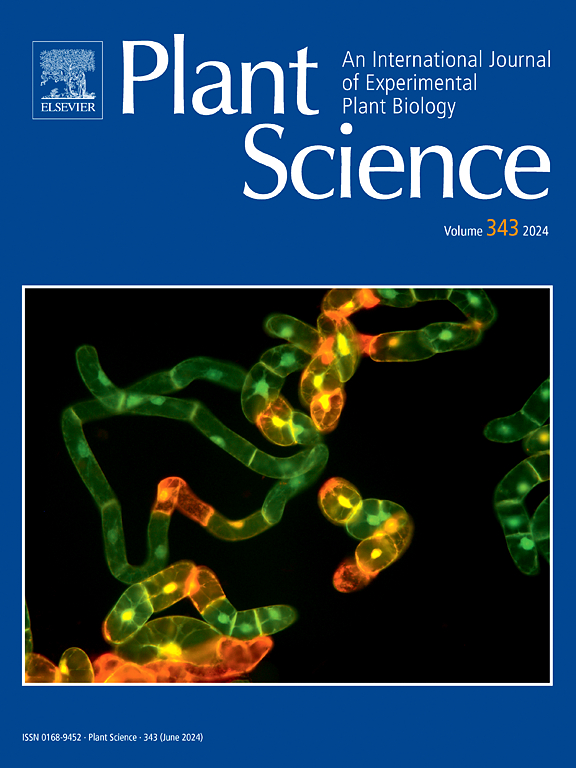油菜和水稻根系mRNA互作组的分析:跨双子叶-单子叶边界的作物物种
IF 4.2
2区 生物学
Q2 BIOCHEMISTRY & MOLECULAR BIOLOGY
引用次数: 0
摘要
RNA相互作用组捕获(RIC)技术的出现对几种真核生物分类群的mrna结合蛋白质组(mrbpome)的表征具有重要意义。迄今为止,已发表的植物poly(A)+ RIC研究仅限于拟南芥,并且仅限于幼苗、悬浮细胞培养、叶肉原生质体、叶片和胚胎。本研究的重点是将RIC扩展到两种作物的根组织,即油菜籽油菜(Brassica napus)和谷类单子叶水稻(Oryza sativa)。通过对油菜和水稻根系mrbpome的优化和应用,分别鉴定出499个和334个组成油菜和水稻根系mrbpome的蛋白,其中182个同源蛋白存在于油菜和水稻之间。在这两种mRBPomes中,大约80% %捕获的蛋白质与RNA生物学相关,其中含有rrm的蛋白质和核糖体蛋白质是最具代表性的蛋白质组。与其他RIC研究中观察到的趋势一致,新的rna结合蛋白被捕获,缺乏已知的rna结合结构域,包括许多代谢酶。来自油菜和水稻的根mRBPome在组成水平上具有高度的相似性,这一点可以通过对已发表的拟南芥ric来源的mRBPome的同源物预测的比较分析,以及我们在这里提出的拟南芥根mRBPome数据来证明。该分析还显示,当与已发表的拟南芥RBPomes进行同源物比较时,油菜和水稻根mRBPomes中的46个蛋白质是独特的,包括最近使用相分离方法鉴定的与所有RNA类型结合的蛋白质。本研究的结果将植物mRBPome扩展到跨越双子叶-单子叶枝边界的两种作物的根组织中,并为rna结合蛋白在作物物种基因表达转录后控制中的功能提供了基础知识,为未来开发有益性状提供了可能。本文章由计算机程序翻译,如有差异,请以英文原文为准。
Analysis of the root mRNA interactome from canola and rice: Crop species that span the eudicot-monocot boundary
The advent of RNA interactome capture (RIC) has been important in characterizing the mRNA-binding proteomes (mRBPomes) of several eukaryotic taxa. To date, published plant poly(A)+ RIC studies have been restricted to Arabidopsis thaliana and specific to seedlings, suspension cell cultures, mesophyll protoplasts, leaves and embryos. The focus of this study was to expand RIC to root tissue in two crop species, the oilseed eudicot Brassica napus (canola) and the cereal monocot Oryza sativa (rice). The optimization and application of root RIC in these species resulted in the identification of 499 proteins and 334 proteins comprising the root mRBPomes of canola and rice, respectively, with 182 shared orthologous proteins between these two species. In both mRBPomes, approximately 80 % of captured proteins were linked to RNA biology, with RRM-containing proteins and ribosomal proteins among the most overrepresented protein groups. Consistent with trends observed in other RIC studies, novel RNA-binding proteins were captured that lacked known RNA-binding domains and included numerous metabolic enzymes. The root mRBPomes from canola and rice shared a high degree of similarity at the compositional level, as shown by a comparative analysis of orthologs predicted for captured proteins to the published Arabidopsis RIC-derived mRBPomes, as well as our Arabidopsis root mRBPome data presented here. This analysis also revealed that 46 proteins in the canola and rice root mRBPomes were unique when orthologs were compared to the published Arabidopsis RBPomes, including those identified recently using phase separation approach that identified proteins bound to all RNA types. The results from this research expands the plant mRBPome into root tissue using two crop species that span the eudicot-monocot clade boundary, and provides fundamental knowledge on RNA-binding protein function in post-transcriptional control of gene expression in crop species for possible future development of beneficial traits.
求助全文
通过发布文献求助,成功后即可免费获取论文全文。
去求助
来源期刊

Plant Science
生物-生化与分子生物学
CiteScore
9.10
自引率
1.90%
发文量
322
审稿时长
33 days
期刊介绍:
Plant Science will publish in the minimum of time, research manuscripts as well as commissioned reviews and commentaries recommended by its referees in all areas of experimental plant biology with emphasis in the broad areas of genomics, proteomics, biochemistry (including enzymology), physiology, cell biology, development, genetics, functional plant breeding, systems biology and the interaction of plants with the environment.
Manuscripts for full consideration should be written concisely and essentially as a final report. The main criterion for publication is that the manuscript must contain original and significant insights that lead to a better understanding of fundamental plant biology. Papers centering on plant cell culture should be of interest to a wide audience and methods employed result in a substantial improvement over existing established techniques and approaches. Methods papers are welcome only when the technique(s) described is novel or provides a major advancement of established protocols.
 求助内容:
求助内容: 应助结果提醒方式:
应助结果提醒方式:


